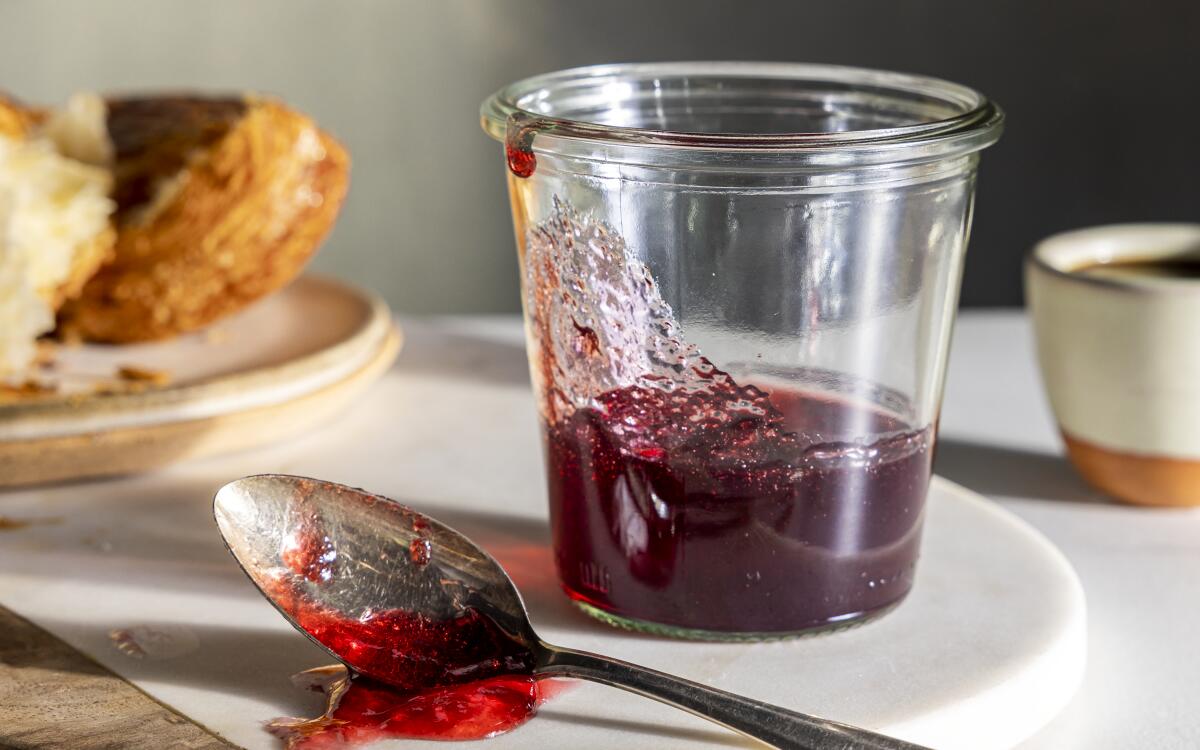Blackberry Jelly With Amaro

- Share via
The dark, inky sweetness of blackberries pairs beautifully with a refreshingly bitter shot of amaro in this grown-up berry jelly. Chopped green apples are added to the berries to provide pectin, which helps set the jelly with its characteristic wobbliness. I prefer amaro Montenegro or Lucano to pair with blackberries, but virtually any amaro that’s not aggressively bitter or too menthol-forward will work. This amount of amaro gives the jelly a back note of bitterness but is not overtly present. If you want a more boozy jelly, add up to an extra ¼ cup but allow the jelly to boil for 30 seconds after you add it so the amaro doesn’t throw off the final set texture.
Rinse the apples under warm running water, then transfer to a cutting board. Quarter the apples — core, skin and all — then cut each quarter crosswise so you have 8 pieces. Transfer all the pieces to a large Dutch oven or saucepan. Rinse the blackberries thoroughly, then add them to the pot with the apples. Pour in the 8 cups of water. (For my 10½-inch-wide, 5¼-inch-deep pot, this amount of water should just cover the fruit and give it room to float freely; if your pot is slightly bigger, add more water until the fruit does so. If your pot is smaller, leave the water at 8 cups.)
Place the pot over high heat and bring to a boil. Reduce the heat to medium to maintain a lively simmer, then cover the pot with a lid. Cook the fruit until the apples and berries more or less fall apart, about 2 hours. Add more water, if needed, throughout cooking to keep the fruit floating freely.
While the fruit cooks, suspend a colander or coarse strainer large enough to hold all the fruit over a large bowl so the bottom of the colander won’t sit in the bowl but rather stays suspended above it.
Remove the pot from the heat and pour the cooking liquid and fruit through the colander; clean and reserve the pot. Cover the fruit and colander with plastic wrap and transfer this setup to the refrigerator. Allow to sit, undisturbed, overnight or at least 8 hours — this allows every last drop of liquid and pectin to come out of the fruit. Place 5 small plates or saucers in the freezer overnight.
The next day, place a fine sieve, preferably lined with cheesecloth, over the reserved pot. Slowly pour the drained liquid through the sieve and, without pressing on the solids in the sieve, let the liquid drain fully into the pot; this helps keep the juice as clear as possible so the jelly is as well. Discard the cooked fruit in the colander, any sediment in the sieve and the cheesecloth. You should have about 6 cups of juice.
Stir in the sugar and lemon juice and add a large pinch of salt. Set the pot over high heat and bring to a boil. Let the jelly cook for about 10 minutes. Remove the pot from the heat, let the bubbles settle and then spoon some liquid onto one of the frozen plates. Return the plate to the freezer for 2 minutes. Remove the plate and push your finger against the face of the plate and through the liquid. If the liquid wrinkles, the jelly is ready. If it’s still too loose, return the pot of jelly to the heat and, once it begins boiling again, cook for 2 minutes longer. Remove the pot from the heat and check the set again. Repeat until the jelly is ready. The process usually takes between 12 and 15 minutes, but it’s best to start checking after 10 minutes anyway.
Once the jelly is set, stir in the amaro. Bring the jelly back to a boil, then immediately remove the pot from the heat. If storing the jelly in jars, use a ladle or large heatproof pitcher or liquid measuring cup to immediately transfer the hot jelly into clean glass jars, filling them to within 1/8 inch of the rim. Cover with lids, let cool to room temperature, then store the jelly in the refrigerator. If storing it in plastic storage containers, cover the pot and let the jelly cool for 15 to 20 minutes in the pot before transferring to the containers. Store the jelly in the refrigerator for up to 3 months.
Get our Cooking newsletter.
Your roundup of inspiring recipes and kitchen tricks.
You may occasionally receive promotional content from the Los Angeles Times.









